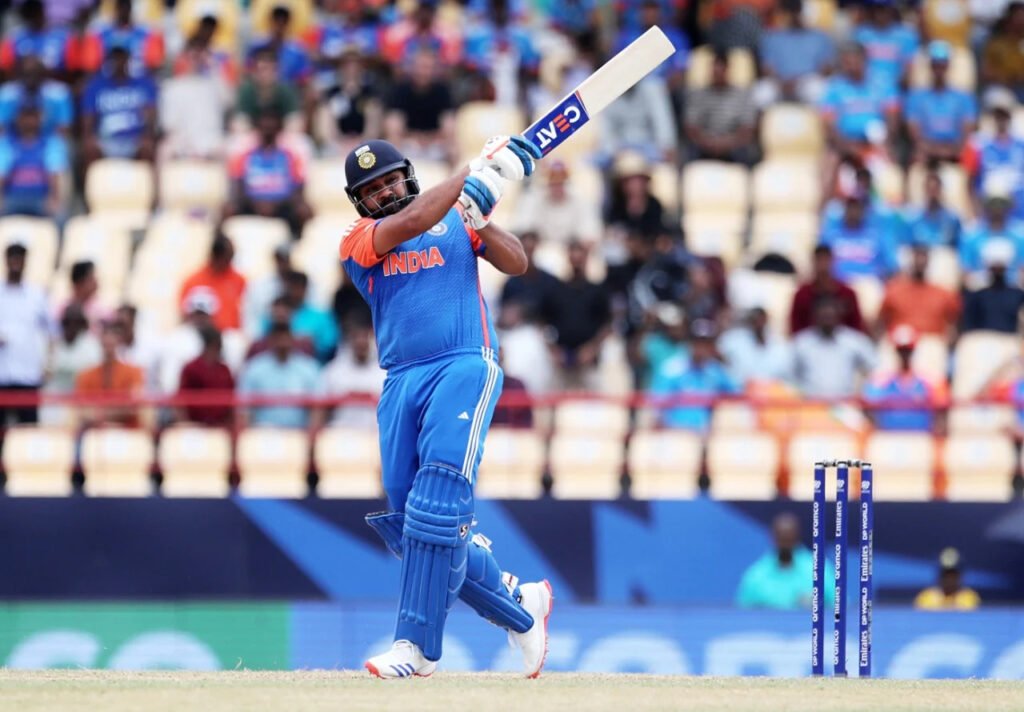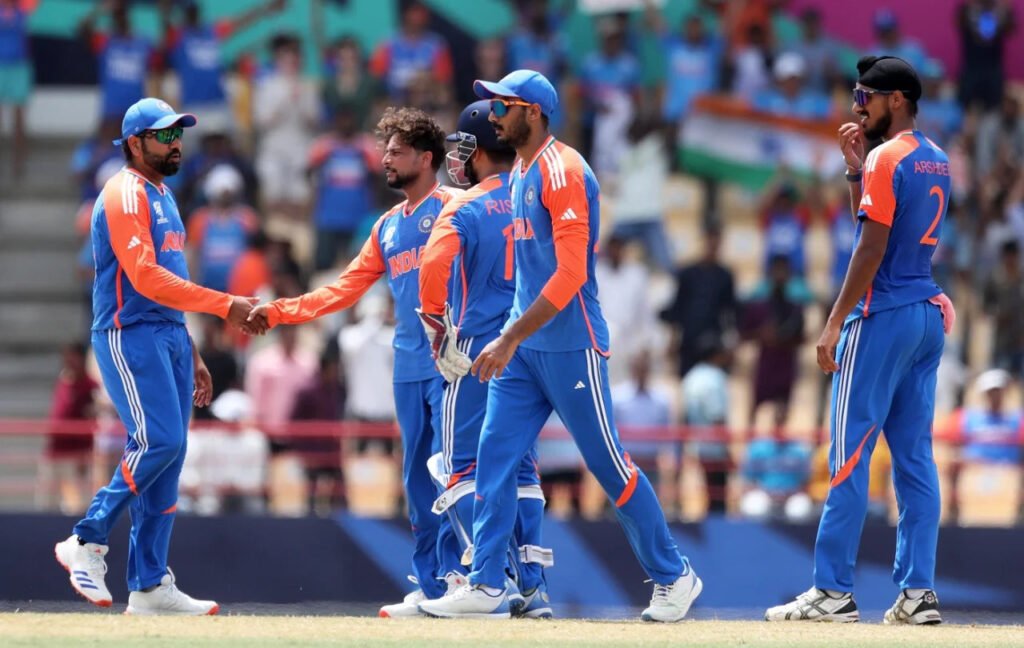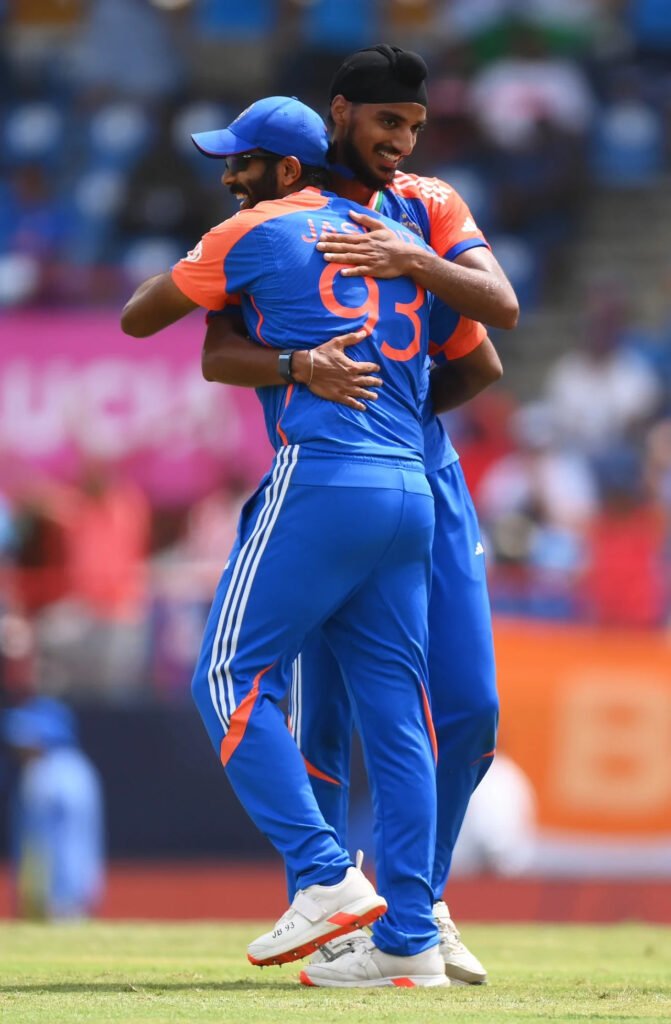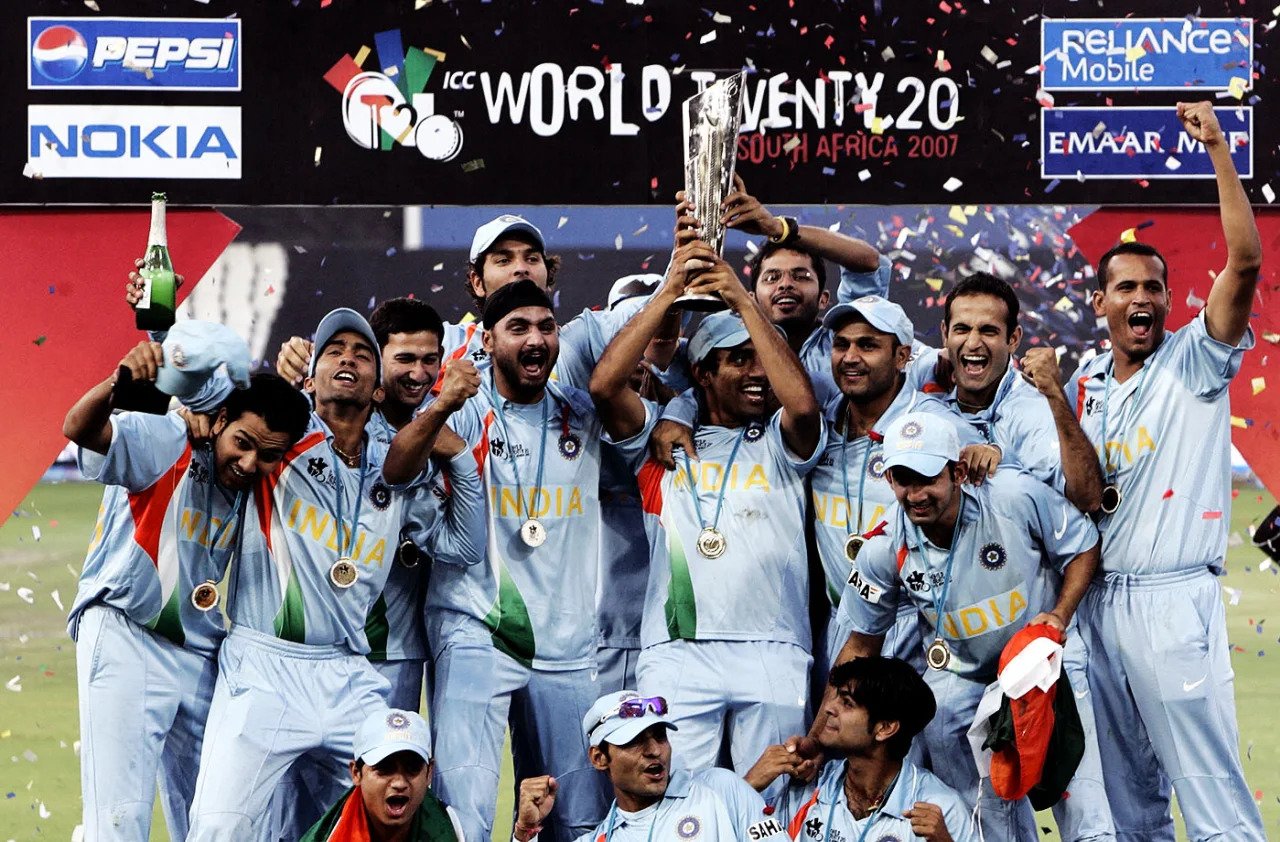Rohit Sharma’s explosive 92(41) powered India to the semi finals of ICC T20 World Cup 2024 with a thumping win over Australia.
With three consecutive victories, India will be facing their formal rival England in the semi final of the ongoing T20 world cup. A repeat of the 2022 world cup semi final where England had the upper hand on India.

Key Performers
India 205 for 5 (Rohit 92, Hazlewood 1-14)
Australia 181 for 7 (Head 76, Arshdeep 3-37, Kuldeep 2-24)
India reached the semi-finals of the T20 World Cup 2024 thanks to the skipper Rohit Sharma. He was magnificent. However, he has been for a while due to his unwavering dedication to playing an offensive game at personal expense. It merits recognition, yet up until now it has only existed intangibly. Maybe it will take the form of an ICC trophy in five days.
India’s captain struck 76 of his 92 runs in boundaries on a beautiful morning in St Lucia, leaving Australia with nowhere to run. He even led them to make errors. Built on a string of unbroken records, 205 proved to be too much. It provided protection from Travis Head as well, which is practically unheard of in the current climate. Australia might yet advance to the final four, but first Bangladesh must do them a favor by defeating Afghanistan in St. Vincent later on Monday (by non-colossal margins).
He was meant to lead his side to victory on November 19, but instead he left with tears in his eyes. On June 24, when his opening partner and world-beating best friend Virat Kohli dropped for a duck, he had cause to think all that hurt could resurface. It’s possible that some people went backward.
Alternatively, Rohit took Mitchell Starc for 29 runs in a single over. In the 5th over, he was 50 off 19 runs. Out of 13, the other end had contributed two. The lowest score at which a player in T20Is when ball-by-ball statistics is available reached a half-century was India’s 52. Rohit wasn’t having fun.
However, Australia worked perfectly in Rohit’s favour. For example, Starc never stopped filling up. It’s his sole occupation. Look for a swing. Strike out at stumps. That was the incorrect length, though, at Daren Sammy Stadium.
There, Josh Hazlewood led the way. Throughout his entire spell, he only made two appearances, both of which were yorkers. He finished with a 1 for 14 record since every other ball was either on a length or just off of it. 24 times was Rohit invited to play his front-foot shots, and he made 71 runs, including five of his seven fours and seven of his eight sixes.
In six of the eleven overs that Rohit bowled, the score reached double digits. He was batting in the same manner as when he is 200 not out in an ODI match. Getting on one knee and slogging it out to a six that thudded against the stadium roof, stunning Pat Cummins, who had two hat-tricks going into this game.
Arriving at the extra cover to slap Marcus Stoinis on the rise, descending the track with the devastating smoothness of water cascading down a rock. A new song has been added to the playlist after attempting a version of the scoop and ending up with a version of the pull.
In the end, he was benefiting from all he was doing. There was an aura to even a defensive push to cover, which caused Australia to misfield and give up a second run.
At the crease with Rohit in the middle, India scored ten fours and ten sixes. They could manage only nine between them when he fell. For that, Starc deserves recognition. Returning in the twelfth over, he changed his stance around the wicket to prevent Rohit from using his arms freely. Although he still went full, he took pace off this time, which was significant enough to make a difference. Broken stumps and a bat unable to make contact with the ball.
Suryakumar Yadav, who was in the middle of his own masterclass and scoring runs in ways that weren’t necessarily logical, was also dismissed by Starc’s slower delivery. Once more, a ball that was close to the wide line wound up on the square-leg boundary, making Cummins the unfortunate receiver.
Between the 15th and 18th overs, India went 21 deliveries without a boundary, but they managed a last-ditch effort when Hardik Pandya hit three sixes in the last two overs to take the score above 200.
Also Read: India vs Pakistan: Thrilling ICC World Twenty20 World Cup Final 2007 Recap

David Warner could be playing his final international match when he fell in the opening over of the chase. He scored six runs off of six balls. But there were still batters in Australia who could dictate terms.
Arshdeep Singh was bowled out for two fours and a six by Mitchell Marsh in an over, and Head even outperformed him by hitting Jasprit Bumrah off the length of the new ball he usually bowls. That forced the Indians to quickly switch to their backup plan, yorkers, and even he bowled a full toss and missed one while under duress.
Australia outscored India by five runs at 65 for 1 to end the powerplay. The script had been turned by Marsh’s power play and Head’s amazing ability to clear his front leg and open up huge areas of the outfield on both sides.
Something unique was brought to India in the shape of Axar Patel. It seemed like a mistake to be a few yards off the fence at deep square leg, especially since it was Marsh on strike. With his bat, the slog sweep flew off. Level. Hard. Said to be headed for six. Even a support staff member was hiding out of concern that it might outshine the fielder.
However, Axar forbade it. Leaping to his feet, he grabbed it with both hands, using only his right. It was an instance where it had to endure, and it did. To celebrate that wicket, all of his teammates ran up to him. The partnership of 81 off 48 was broken against the flow of play.
Glenn Maxwell was hard at work countering the edge India possessed because of their superior spinners. When he noticed that Ravindra Jadeja had nobody on the boundary at third man, he decided to go for a reverse sweep. This meant that he was hitting with the turn but against the wind, which presented a serious issue when it was strong enough to practically carry Hardik away as he was running in to bowl.
Somehow, Maxwell’s wrists overcome it. He appeared to be dangerous. Perhaps sufficient to defeat Kuldeep Yadav. He was bowled after charging at India’s wristspinner. That thing ought to be framed and hanging on a wall. Maxwell was messed up in so many ways by it. It wasn’t moving as quickly as he had hoped. It was not as long as he had needed. It made the complete opposite turn. And it left a mess on his stumps. It was all about that ball’s dip.
In the next three overs, India struck twice, with Bumrah smashing Head with his offcutter. Australia’s greatest chance, needing 53 from the final 18, was to narrow the margin of defeat.
Arshdeep Singh: Mastering Wind Conditions in T20 World Cup 2024
Against Australia in a dramatic match at the T20 World Cup 2024, Arshdeep Singh displayed his bowling prowess with an outstanding performance. His strategies for dealing with wind conditions not only clarified the tactical difficulties bowlers have, but they also highlighted how important flexibility is to the game of cricket.
The important wickets of Tim David, David Warner, and Matthew Wade that Arshdeep took for 3 for 37 were essential in India’s 24-run victory. His post-match comments emphasized the tactical subtleties of managing wind dynamics on the field. He stressed that in order to keep opposition batters from getting an advantage, it is imperative to counteract the wind’s influence.
Arshdeep clarified, “It’s imperative to stay ahead of the wind in such conditions.” “Bowling smartly against the wind direction allowed us to control the game and limit the opposition’s scoring opportunities.” Another excellent player, Josh Hazlewood, acknowledged the difficult circumstances and said a par score of about 180 was doable. But India’s batsmen, spearheaded by an outstanding effort from Rohit Sharma, took the team to a threatening total, giving their bowlers a cushion to work with.

Part of the reason for Arshdeep’s success in the tournament—he and Afghanistan’s Fazalhaq Farooqi topped the wicket charts—was Jasprit Bumrah’s pressure at the other end. Because of Bumrah’s economical bowling, batsmen were compelled to take chances against Arshdeep, which helped India make significant strides.
Arshdeep said, “Our cooperation in applying pressure was essential.” “Bumrah’s consistency allowed me to focus on delivering my best, resulting in wickets and contributing to our team’s success.”
Arshdeep’s strategic thinking and flexibility in responding to shifting circumstances were clearly evident as the game grew more intense. Working well together with spinners like Axar Patel and Kuldeep Yadav, he was crucial in keeping Australia’s momentum from gathering steam during their pursuit.
Australia’s T20 World Cup 2024 Survival Hopes Hang by a Thread
Australia’s aspirations of winning the T20 World Cup in 2024 by defeating Afghanistan present a vital moment in their pursuit for a historic triple crown in cricket. Australia’s destiny will be decided by the result of this match, as their prospects largely depend on complex net run rate computations.
Australia’s momentum wavered after a run of wins when they lost consecutive matches against Afghanistan and India. Travis Head’s tenacious 76 in the match against India demonstrated the team’s resiliency in the face of certain elimination.
The team’s general anticipation was voiced by Josh Hazlewood, who said, “We’re hoping that Bangladesh can get the job done.” The team is ready for an anxious wait to find out how they are doing in the competition as they watch the big game together.
Australia’s unexpected turn of events highlights the fierce competitiveness in Twenty20 cricket, where each game is extremely important. In order to maximize player performance, Hazlewood stressed the importance of maintaining balance in tournament arrangements while acknowledging the difficulties presented by condensed timetables.
T20 cricket is unpredictable, which adds to the pressure as teams like Australia walk a tightrope between qualification and elimination. Hazlewood discussed the competitive nature of the format and emphasized the significance of playing well each and every time.
Australia’s reliance on outside results creates an unparalleled level of anticipation for their T20 World Cup adventure as they wait for the result. Hazlewood’s experience in comparable circumstances, including IPL matches, highlights the distinct dynamics of the high-stakes situations in international cricket.
Australia’s players show resilience in the face of uncertainty, willing to accept their fate with fortitude and good sportsmanship. Both spectators and participants are on the edge of their seats as the drama plays out, perfectly capturing the excitement and suspense that characterize elite T20 matches.





